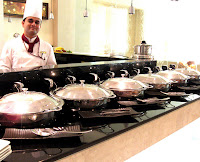In Doha I found evidence that the economic downturn may be pervasive right now, but some people have faith that it will be short lived.
Visiting
 Qatar Airways’ Premium Terminal in Doha, you would never know there’s a recession.
Qatar Airways’ Premium Terminal in Doha, you would never know there’s a recession. Many of us have either been lucky enough to have been inside airline VIP lounges, or at the very least, we’ve walked past them en route to our gates.
They are the oases of the airports, places to relax, or patiently wait for flights when there are delays.
Many international airlines upped the ante years ago by creating different lounges for their first and business class passengers.
But now, in the global game of one-upsmanship, some foreign carriers have gone a step further. In Germany, Lufthansa built a separate, all luxury, dedicated first class terminal, complete with its own restaurant, immigration, security and customs, and stylish way of getting you to your plane—by chauffeured Mercedes or Porsche, driving along the tarmac directly to the plane.
Not to be outdone, the folks at Qatar Airways have now built super, over-the-top first class terminal at its main hub in Doha. And if you’re lucky enough to experience it when departing this country, well … then, you have really arrived.
Valets meet first and business-class passengers to load bags onto luggage carriers.
You line up … never.
A concierge escorts passengers to plush leather chairs at the check-in desk. Besides a fully serviced business center and three conference rooms, there are men and women’s prayer rooms, a children’s play area and nursery complete with on-call nannies, a room for families, and a video game room. A Duty-Free shop is dedicated entirely to upper-class travelers. The First Class Lounge additionally has a spa with showers, a sauna, Jacuzzi, sleeping rooms, and massage treatment rooms. There’s even a medical center with a doctor and nurse on staff.
Three miles away, the new Doha International Airport is being constructed to better handle an expected increase in passenger traffic. Designed to handle 24-26 million passengers, the new terminal will double the capacity of the old terminal. The first phase is expected to be completed in 2012, the second by 2015. A new and even more luxurious Premium Terminal will replace the current one.
In fact, it’s not just the airport that’s getting an overhaul. Even in this tough economy, Qatar Airways is moving ahead with its long-term plans to expand operations to more than 100 cities globally. Qatar Airways announced last Wednesday that it plans to launch scheduled flights to Australia and expand its operations in India and Europe, and the carrier will increase frequency to several destinations in its network this summer.
Qatar Airways is also planning to add one new aircraft to its fleet every month, with more than 200 new Boeing and Airbus aircraft worth more than $40 billion already on order.
Global economic crisis? What global economic crisis?










